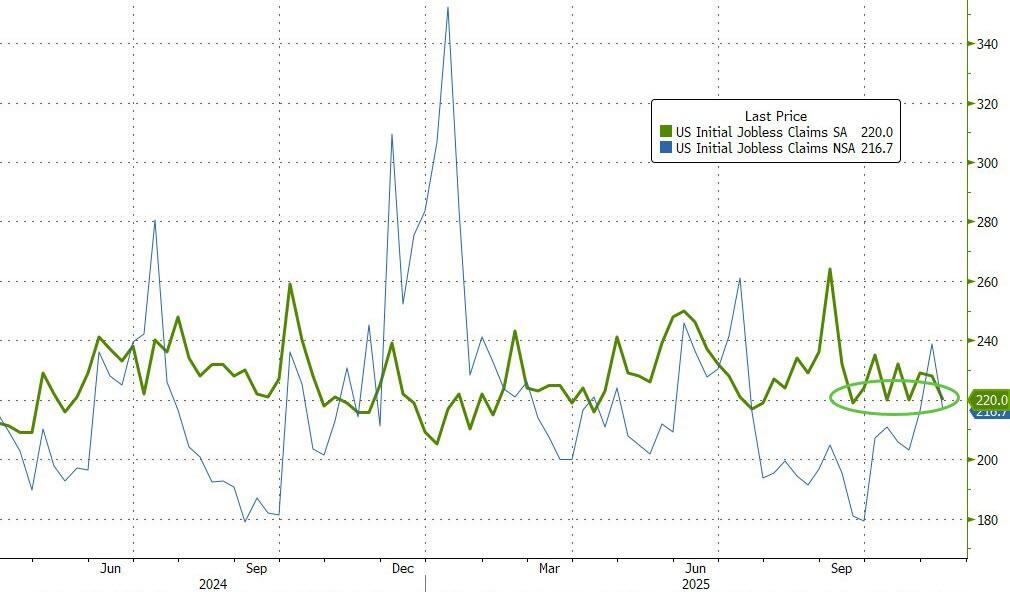
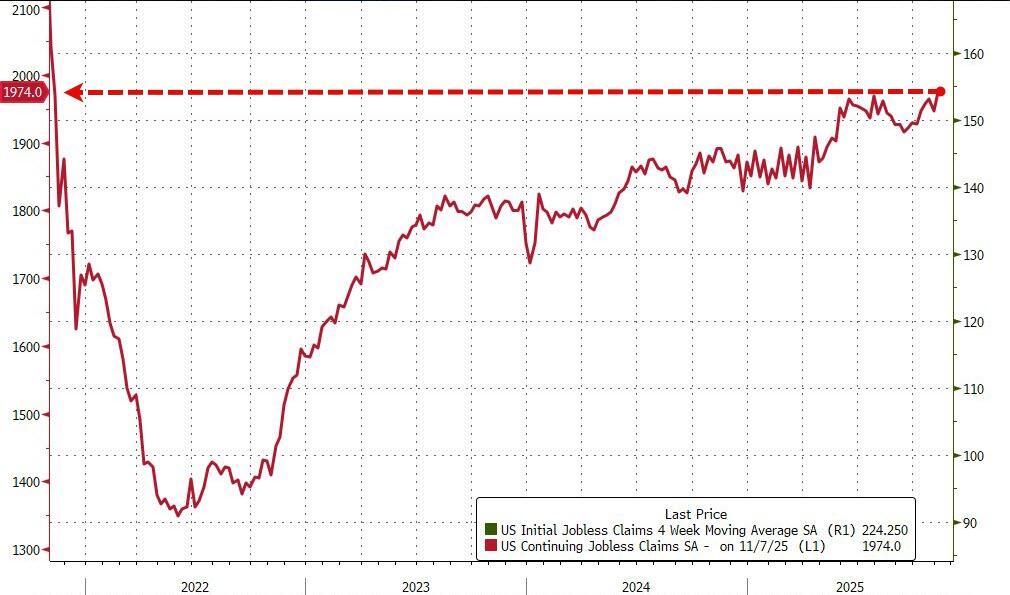
Following are my personal comments on specific markets and issues. I chart markets for a hobby and my comments are the result. They are not recommendations to buy or sell anything and should not be thought of as such. They are for entertainment purposes only so enjoy.
Please remember, the following is pure speculation based only on my experience and chart patterns. "Every sunken ship has a room full of charts."
David Bruce Edwards
Nov 22, 2025
Note - I got a new wider screen monitor and when I look at this web site with the screen size in full, the site spacing does not come out properly. By making the window less wide all of the text and graphics slide into place. Perhaps you are having the same experience. DBE.
As usual, I will show pictures and graphs found on Zerohedge.com, Sentimentrader.com, which include the Seasonality charts and charts made on Barchart.com. I will also mention "cycle low timing bands" suggested by another market website to which I subscribe, Cyclesman.com.
Now that the government is open again we are getting some official data. Economists are still watching the interplay between inflation and jobs. The theory is that the Fed is getting more worried about jobs than inflation and will continue cutting overnight lending rates in December as the job market shows weakness. We got a jobs number for September that showed a gain of 119,000 which was higher than The Street anticipated but the unemployment rate ticked up a bit to 4.4%. Chairman Powell threw cold water on the "Fed will cut" theory, telling analysts that a rate cut in December is not guaranteed and will depend on the data. The next jobs report will be for November employment and it will come out on Dec. 19th, after the Fed's meeting.


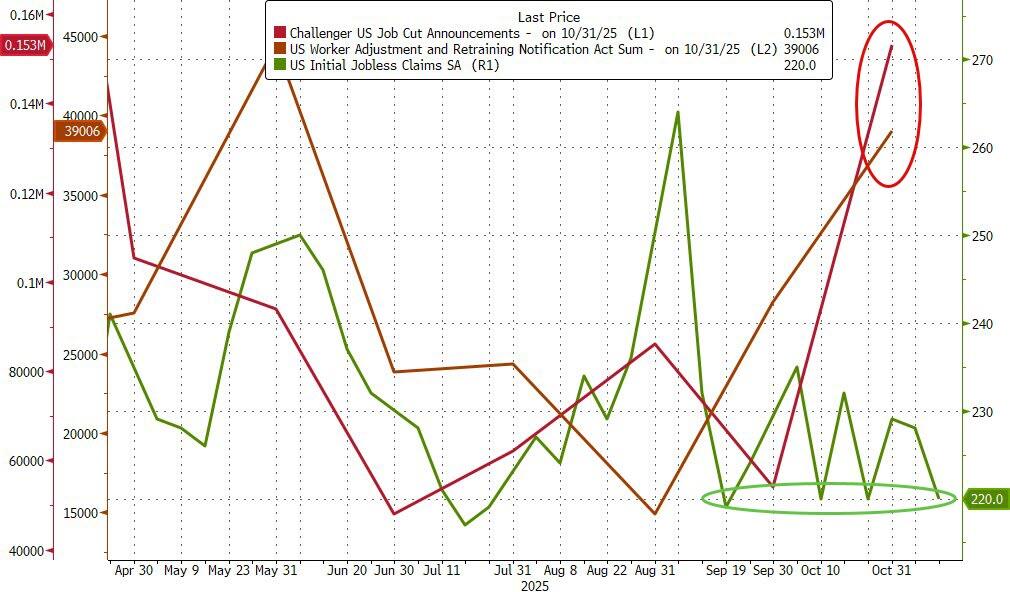
The latest numbers on New Claims for Unemployment benefits do not support the weak jobs thesis (upper left). The reading came in at 220,000, near the lower end of the recent range. Continuing claims rose slightly (right), supporting the "slow firing, slow hiring thesis." One analyst on Bloomberg said that unemployed workers are finding it very hard to find jobs and the average length of unemployment is rising.
The graph directly to the left contrasts the government's official data (green line) with Challenger Gray's data and the legally required notifications of large layoffs being submitted. If we are charitable and assume that there are a few months lag then we should expect the New Claims numbers to head higher in December and January of next year.
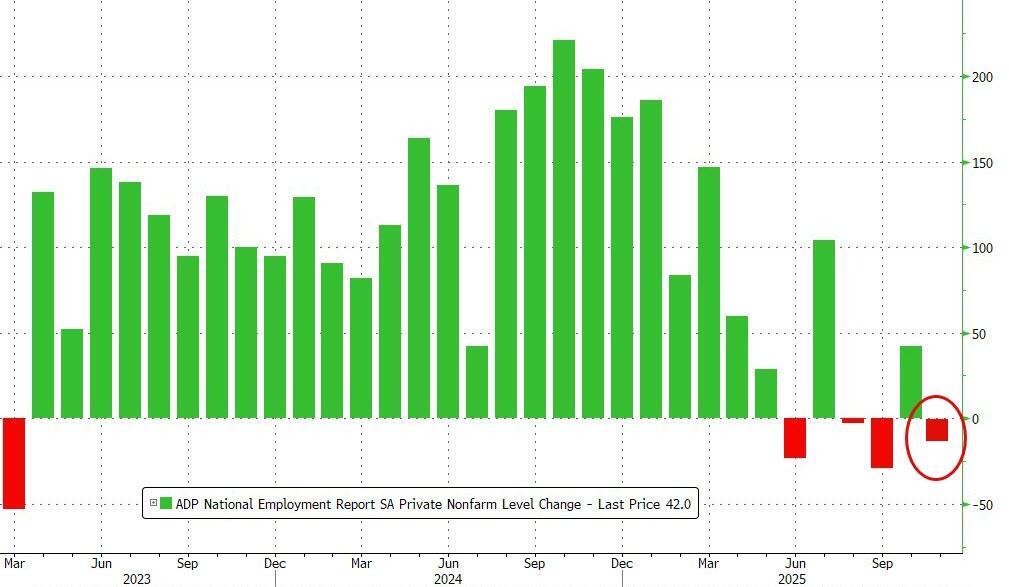
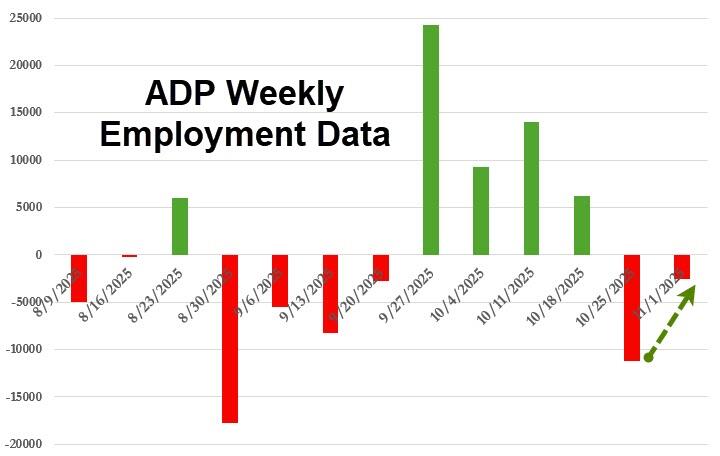
The most recent ADP data showed another week of job losses (left). When the weekly numbers are extrapolated into a monthly number (right) it also shows a decline for the month of November (right).
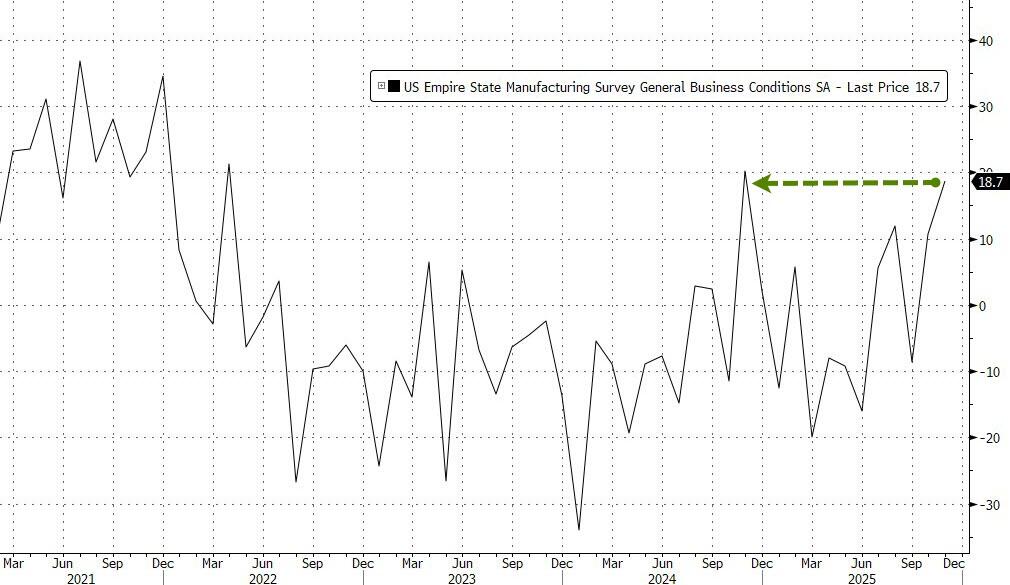
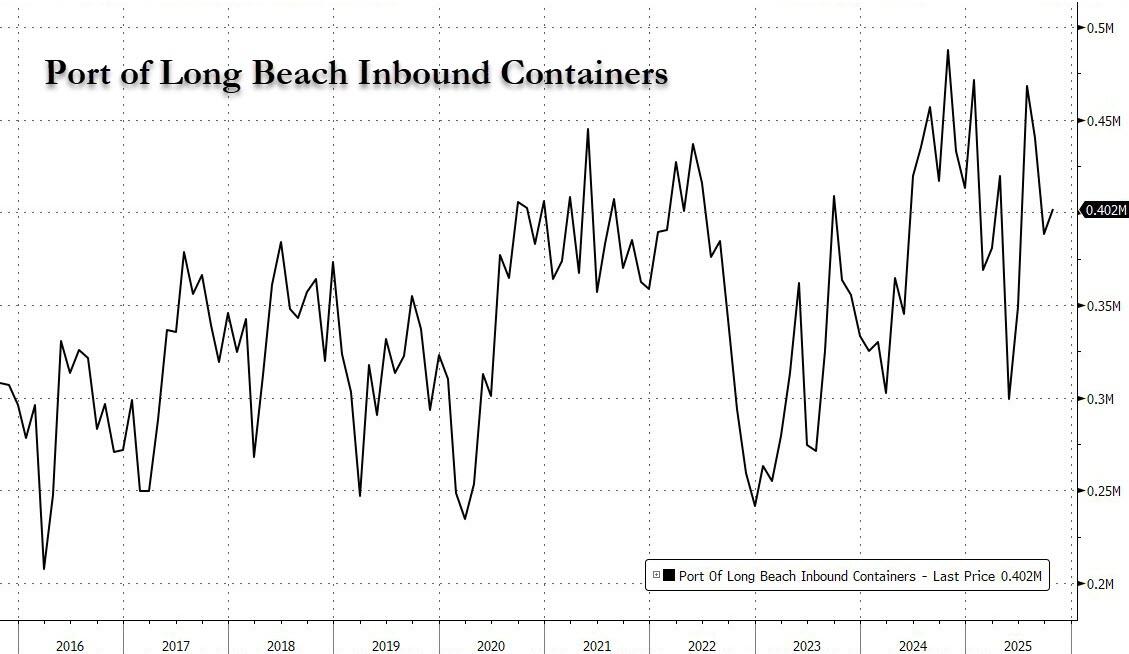
The Empire State Manufacturing Survey was solidly positive (left) which shows that not all is doom and gloom outside of AI. The right side graph tracks the inbound freight into the Port of Long Beach. It was up slightly after dropping for months. Part of this could be due to importers front running tariffs last year by building inventory. However, I watched an interview with FreightWaves, a company that tracks and analyzes the movement of freight by air, boat, rail and trucks. Recession Warning: The Real Economy Is 'Very, Very, Very Weak' | Craig Fuller @FreightWaves He says that based on freight movements, the real economy is much weaker than the official numbers that are pumped up by AI related activity. He says that in the past, lower activity like we are seeing now led to recessions.
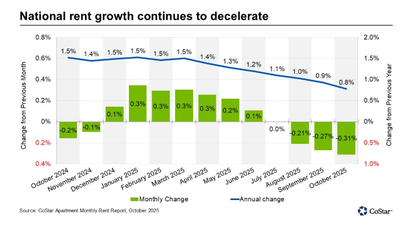
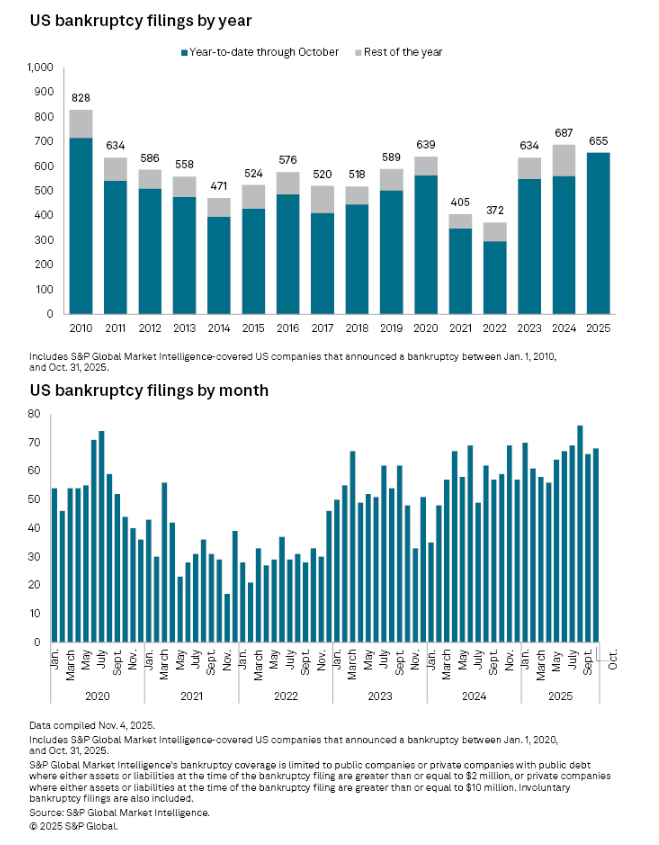
On the left is some good news. In many markets, rents are decreasing. Much of this has to do with the borders being closed and reverse immigration. Some real estate analysts say that there was overbuilding of multifamily units in many metropolitan areas based on the belief that illegal immigrants were going to continue to flow over the border with governments paying for their housing. Now that things are headed in the opposite direction, vacancies are rising. The bad thing about this is that many of the units of rental housing were financed by short term loans that will have to be rolled over. With more vacancies the values of the properties will be less and loan officers will be hesitant to lend enough to cover the outstanding principal. This will lead to defaults. On the right is a graph that tracks corporate bankruptcies. 2025 is likely to have one of the highest bankruptcy filings since the Great Financial Crisis.
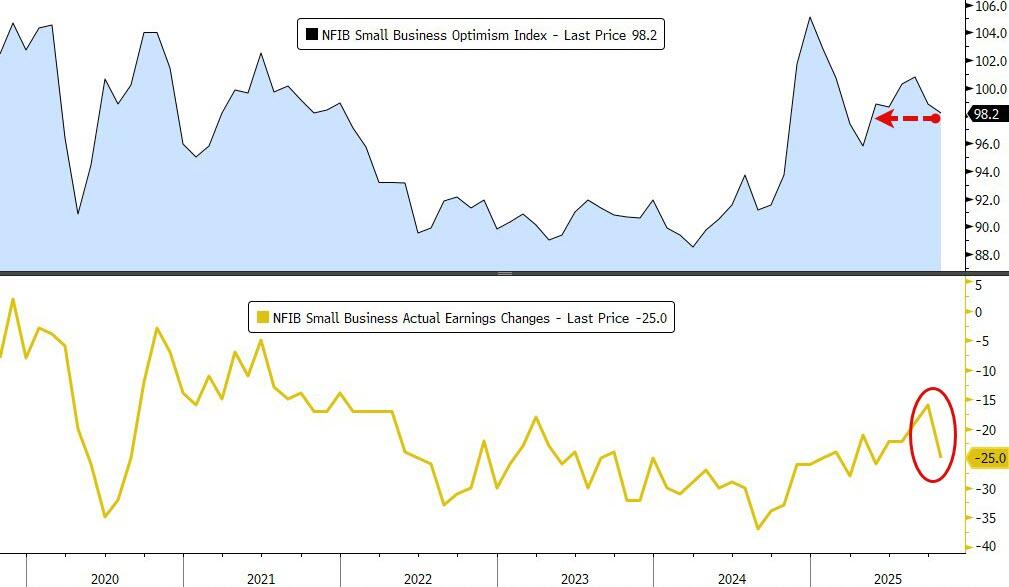
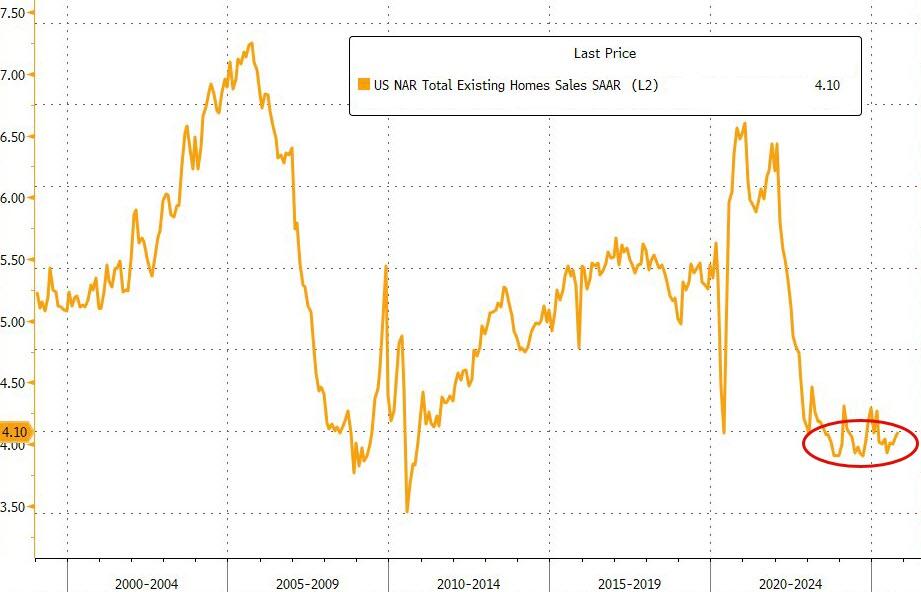
The National Federation of Independent Businesses takes polls of their members who are small business owners. Their optimism or pessimism is very important because most of the jobs in this country come from small businesses and when they are pessimistic they are not going to hire workers. Drops in optimism also tend to be an early warning of a slow down in the economy. The latest survey (left) showed a drop in optimism and recent earnings. On the good side of the ledger, existing home sales rose a bit last month when mortgage rates fell. Real Estate analysts say that we need to see something in the 5% range to unfreeze the market.
Last time I mentioned potential problems with current data center technology and that "smart money" would lighten up and they did. I also wrote that the billions in bonds being issued to finance them could trade at a discount. During the week, Bank of America's chief strategist said that selling short these bonds could be the best trade for 2026. I also mentioned "liquidity" which is the amount of money available for financing things. As usual, when I get interested in something, I think I am alone and within a short time, everyone is talking about the same thing. It turns out that I am just part of the "herd." I want to write about this because you are going to hear more and more about "liquidity" over the next year as it becomes a bigger investment theme than "earnings."
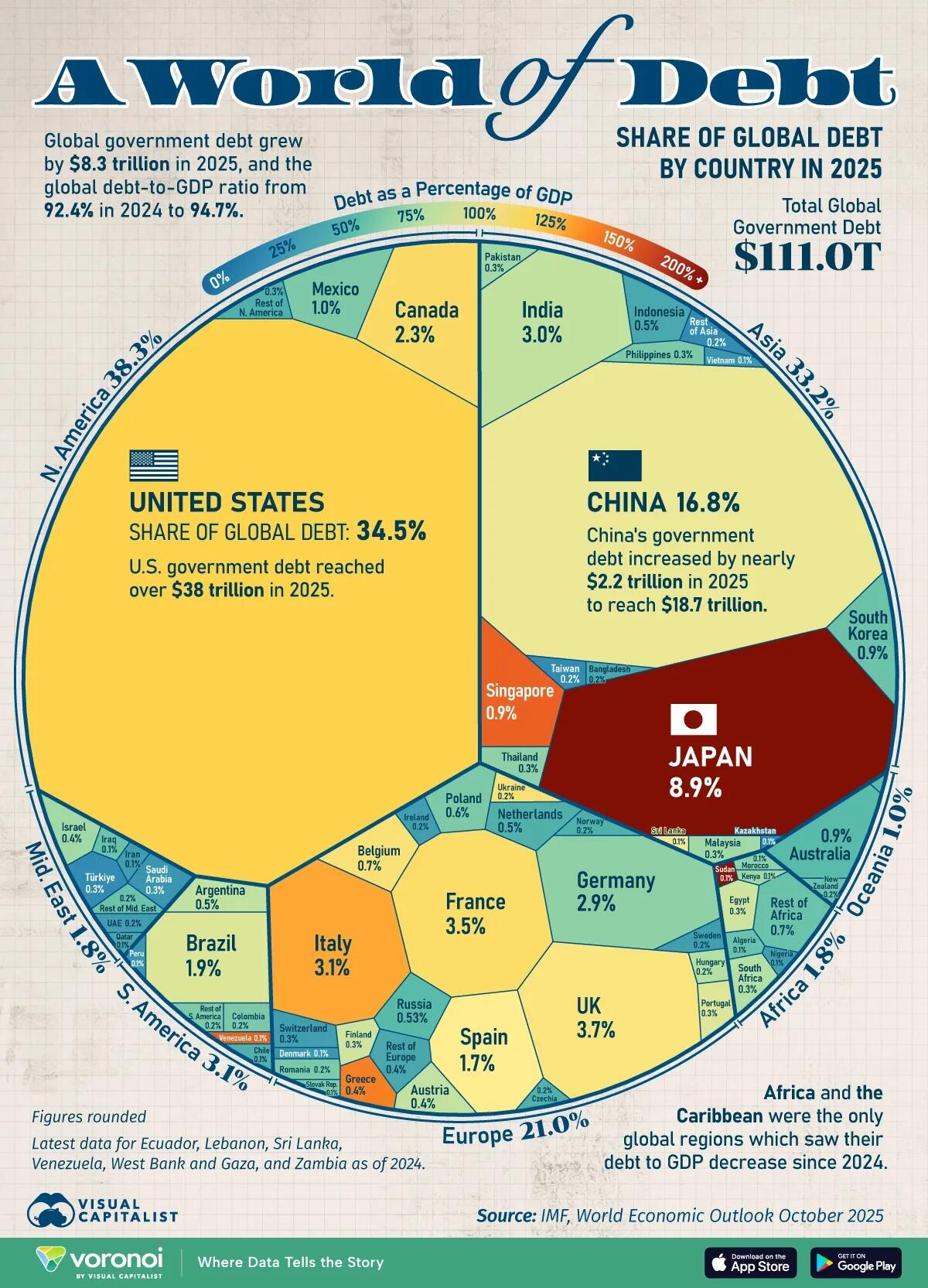
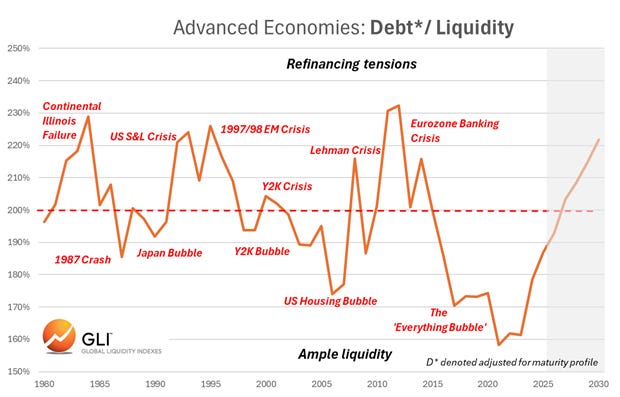
The easiest way to delve into the world of liquidity theory is to read the work of Michael J. Howell. He has a Substack and you can find him on various You Tube interviews. I am making my way through Capital Wars, The Rise of Global Liquidity which he wrote before COVID. Some of it requires more knowledge of the inner workings of the bank and credit system than I possess so it is not something you can breeze through quickly. Here are the basics and why this concept will shape the investment world. As shown by the upper left picture, the world is mired in debt with the U.S. and China leading the way. In economics class we all learned that companies take out loans to do things like build plants, buy equipment or finance the lag between production and when they get paid for the products or services they provide. This is no longer true. Nearly all the current borrowing is refinancing the debt that was initiated when interest rates were lower. This includes sovereign debt, such as the bills, notes and bonds issued by our Treasury and other governments and corporate debt. On top of that, there are billions borrowed overnight to grease the skids of the financial markets. This involves derivatives of all types including leveraged products and carry trades. Howell gives an example of over a trillion Dollars in U.S. Treasury Bonds being financed in one of those trades that involves borrowing on the short end of the curve, buying the long term bonds (that pay a higher rate than the borrowing costs) then selling short Treasury Bond Futures in an arbitrage that nets small amounts per dollar but when leveraged, makes it worth while. Over the next few years, the world is running into a "debt wall." This is the trillions of dollars in outstanding loans that will mature in the next few years and have to be rolled over. The upper right graph is from Howell's Substack. The orange line tracks how much liquidity is in the world system. The dashed red horizontal line is his estimate of how much liquidity is needed in the system. When the orange line is above the red, things are too tight and the markets run into problems. Excess liquidity creates bubbles. According to his estimates, we are now on the tight side which means problems. This is why you read so many economists predicting another round of QE by the Fed.
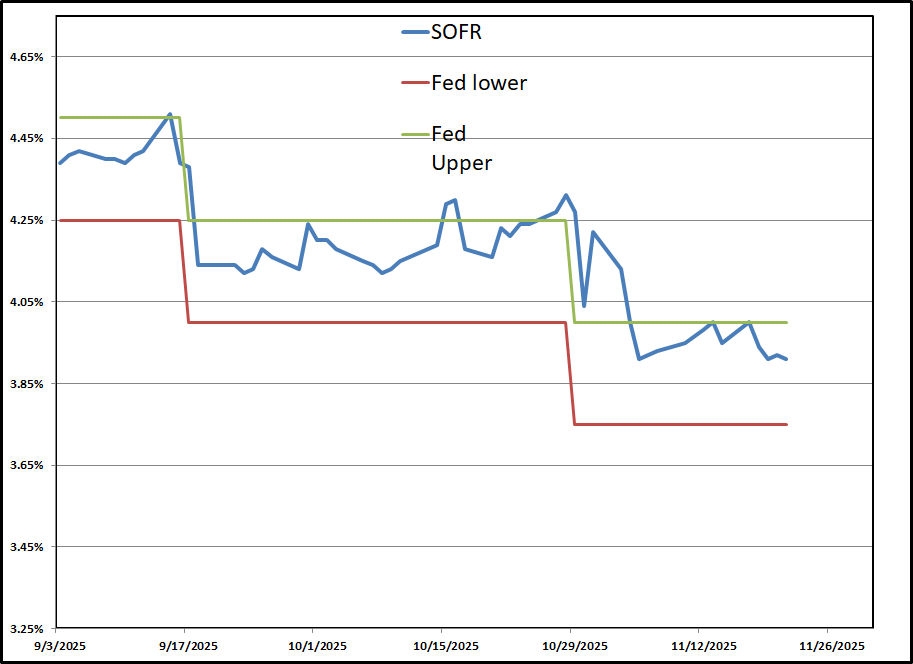
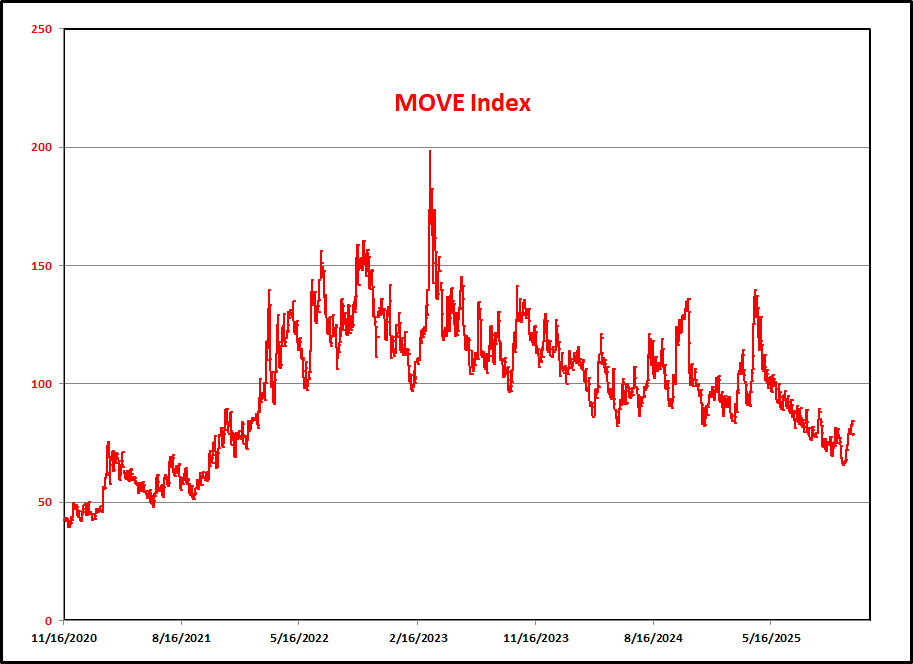
At the heart of the refinancing world are "repos." These are short term loans that are overnight and up to two weeks in duration. These loans require high quality collateral which is nearly always U.S. Treasury debt or German Bunds. Party A sells their debt instruments to Party B for cash along with an agreement to buy the debt instruments back at the end of the duration of the loan at a slightly higher price. The difference in price, when divided by the Dollar amount of the loan works out to an implied interest rate. If Party A is unable to buy back the debt instruments then Party B takes possession and can sell them in the open market. Here are the things that indicate stress in the credit markets. SOFR stands for Secured Overnight Financing Rate. This is the implied interest rate at which repo transactions are being done daily. The current Fed Funds rate range is 3.75% to 4%. Theoretically, SOFR should be at the bottom end of the Fed Funds rate because the borrowing is totally secured with trusted collateral. When SOFR is at the upper end of Fed Funds or above, it is an indication of stress. The left side graph shows the recent path of SOFR in blue. The green and red lines are the current boundaries for Fed Funds. You can find SOFR at https://ycharts.com/indicator. The upper right side graph shows the MOVE Index. This is a VIX for bonds and tracks volatility in the bond market. It effects liquidity because when bond market volatility increases, by selling off, lenders are worried about a drop in the value of posted collateral. In tranquil times, if you use 10 million Dollars worth of T Bonds for a repo transaction, the lender will be willing to lend almost 100%. When volatility hits the bond market, lenders will discount the current value out of fear that if you default, the collateral might be worth less than the loan. So, an upward move in MOVE decreases liquidity. Other things will influence lender's willingness to lend and the haircut given on collateral. If the borrower is big into Private Credit and there are rumors that many of these deals are non-performing, the haircut will be bigger or the loan might be refused. If stocks just had a bad week and everyone is wondering what is going on in the economy, lenders will be more cautious. All these things decrease liquidity.
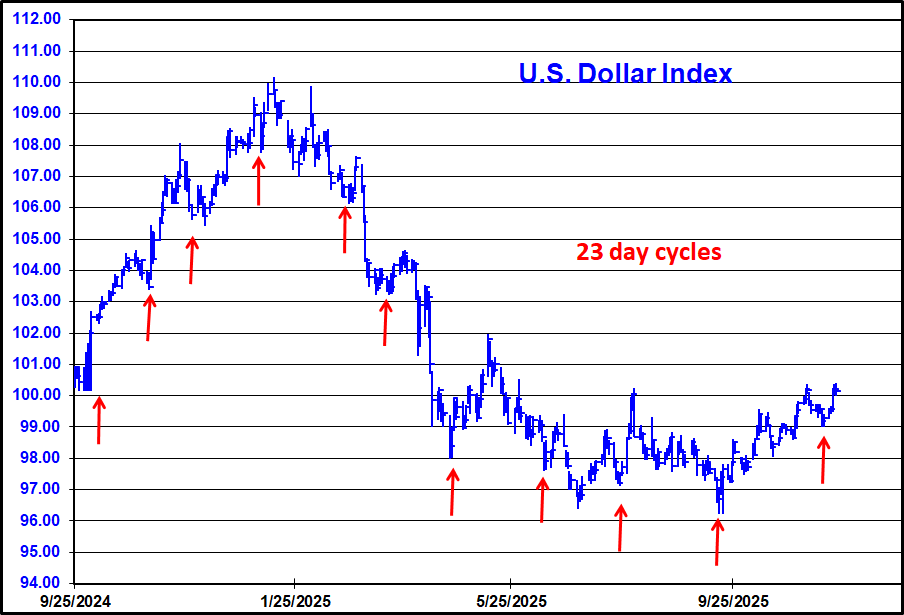
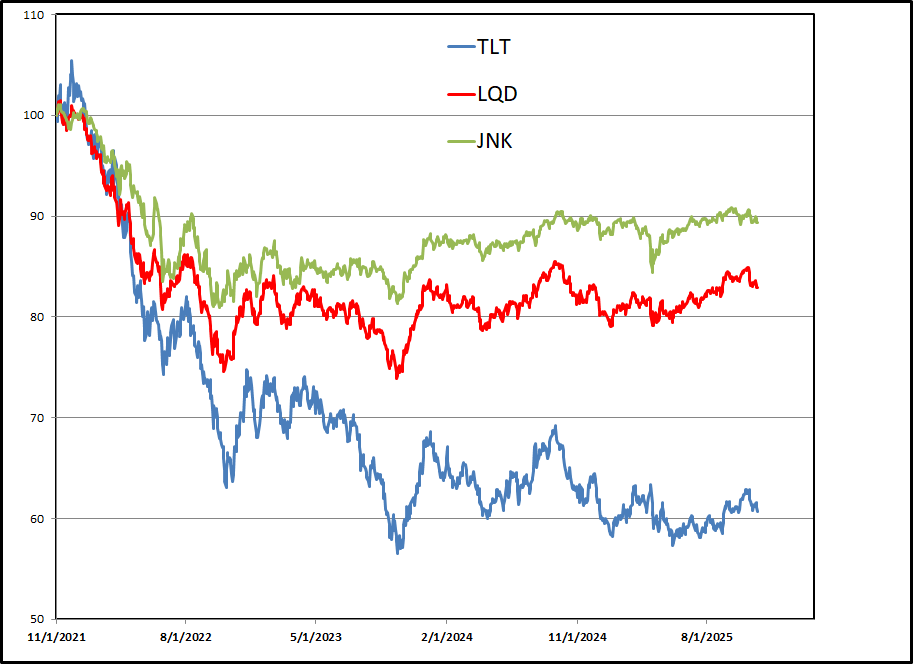
Another very important factor is the value of the U.S. Dollar. Despite claims that the world is abandoning the Dollar, most big time borrowing is Dollar denominated. Billions of loans in China are Dollar denominated. When the Dollar goes up in value (as it has recently) it decreases world liquidity because foreign entities have to make more in their local currencies to pay the same amount of interest on their Dollar denominated loans and it is the same if they have to pay it back. On the right is a graph of TLT, the ETF that tracks longer dated U.S. Government Bonds, LQD, the ETF that tracks high grade Corporate Debt and JNK, the ETF that follows debt issued by creditors with poor credit ratings. The graph is in log scale with 100 being around the top of the bond market (low in interest rates) in late 2021 and early 2022. You can see the path of all three markets. One way to look at these graphs is to say that because of the structural debt of the U.S., investors prefer to hold corporate debt and even low grade debt more than government debt. Another way to look at it is to say that the movement of these markets reflects the liquidity cycle. When liquidity is abundant, investors prefer riskier assets such as corporate debt and even junk bonds. Stocks do very well and at the height of the liquidity cycle, some or many commodities rally. As liquidity dries up, so does the ability to finance things and money drains out of stocks, commodities and private assets and seeks the safety of Treasuries. In future updates I will include these graphs as a way to get a handle on liquidity. If you just care about gold, silver and stocks, this has been a boring stroll down a side street but with a refinancing crisis in front of us, you are going to hear more and more about these concepts. And don't think that Central Bank gold and silver is safe during a liquidity crunch. When things get tight, everything is a target for raising cash. Yes, you can borrow against your gold as opposed to selling it but it is a distinction without a difference because either the owner or the lender will sell short gold in the futures or forward markets to hedge against it dropping below the loan value.


Here is the latest on the yield curve of the U.S. Government debt market. The Fed controls very short term rates. Some analysts say that the Fed will not cut if the 3 month T Bill is less than half a point under the current Fed Funds rate. Three month T bills finished the week at 3.834%, in the middle of the Fed Funds target rate. Others say that the key rate to watch is the interest paid on a 2 year Treasury Note. The two year finished at 3.505%, not that far below the current target range.

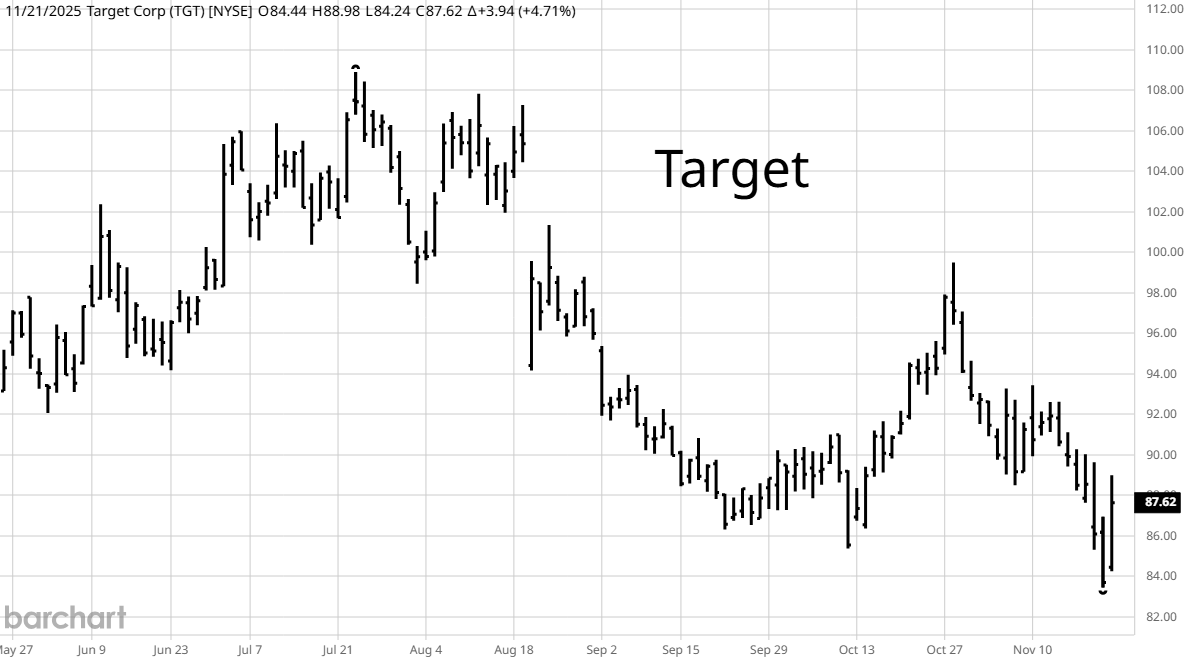
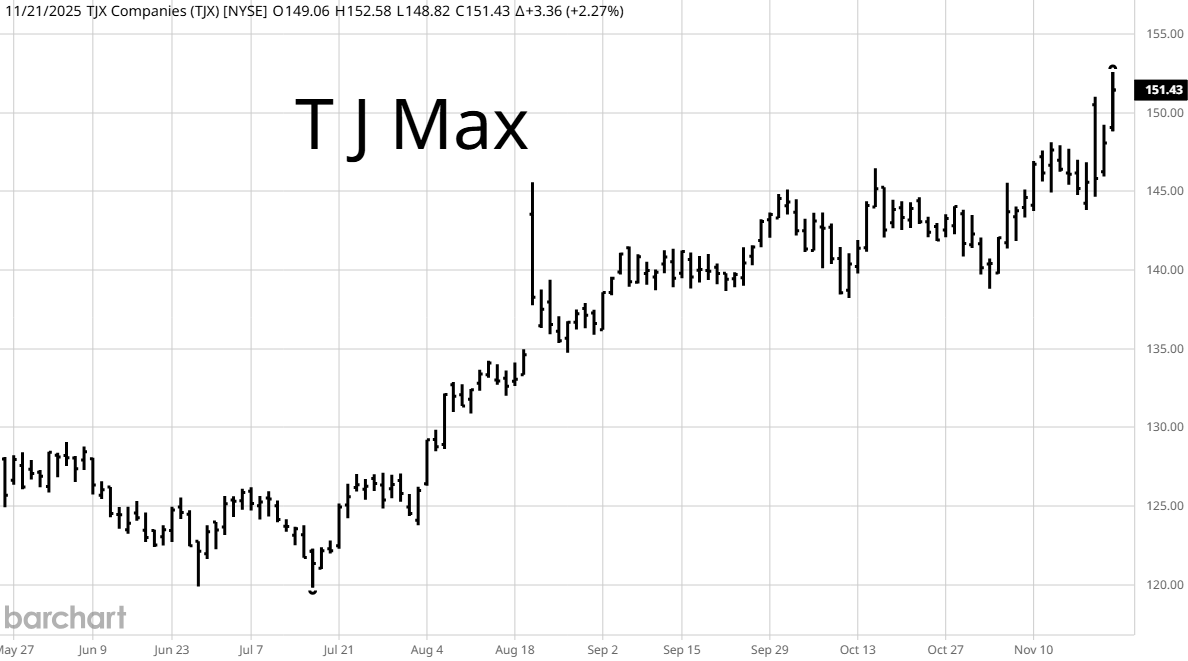

The four graphs above capture the economic reality for much of our population. Home Depot and Target reported poor earnings and gave mediocre guidance. People don't have the money to spend on home projects and according to Zillow, 53% of homes in the U.S. lost value. Target tries to be slightly up-market from Wal-Mart with prices nearly as good as Wal-mart's but if you are short on money, why not go to Wal-Mart Stores and get the best deal? TJX is also a big clothing discounter. Shoppers are scaling back their purchases and going to the stores offering the absolute cheapest prices. Wal-Mart is now the number one grocery store in the country. You don't get your groceries from Wal-Mart if you have money to spare.
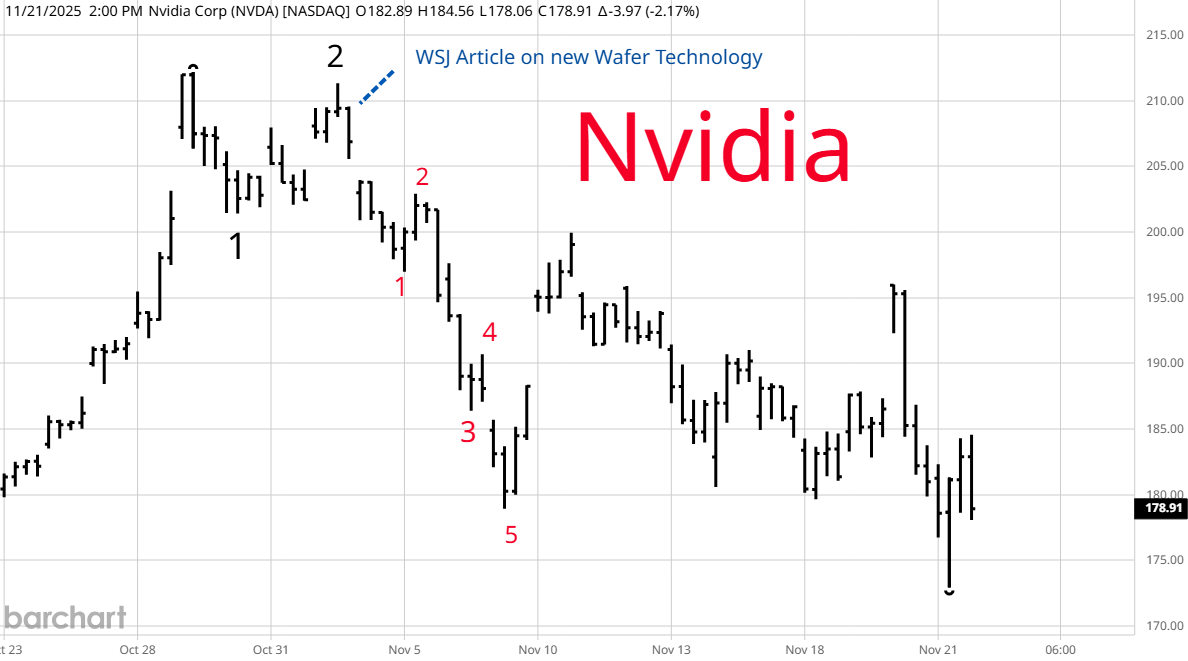
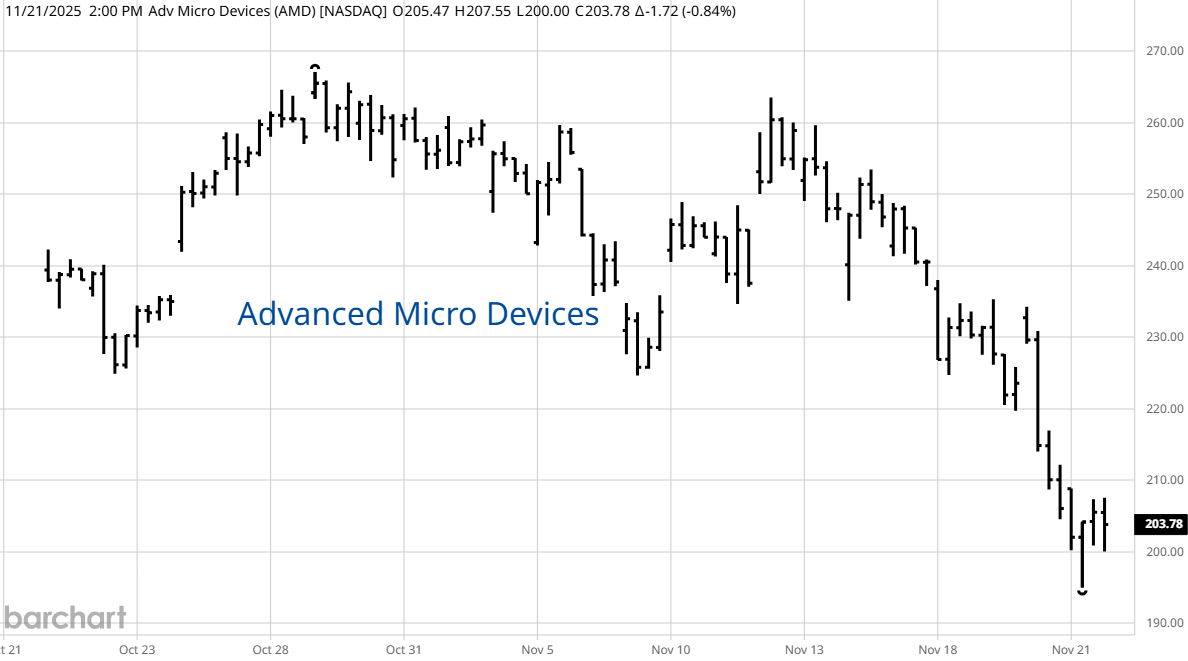
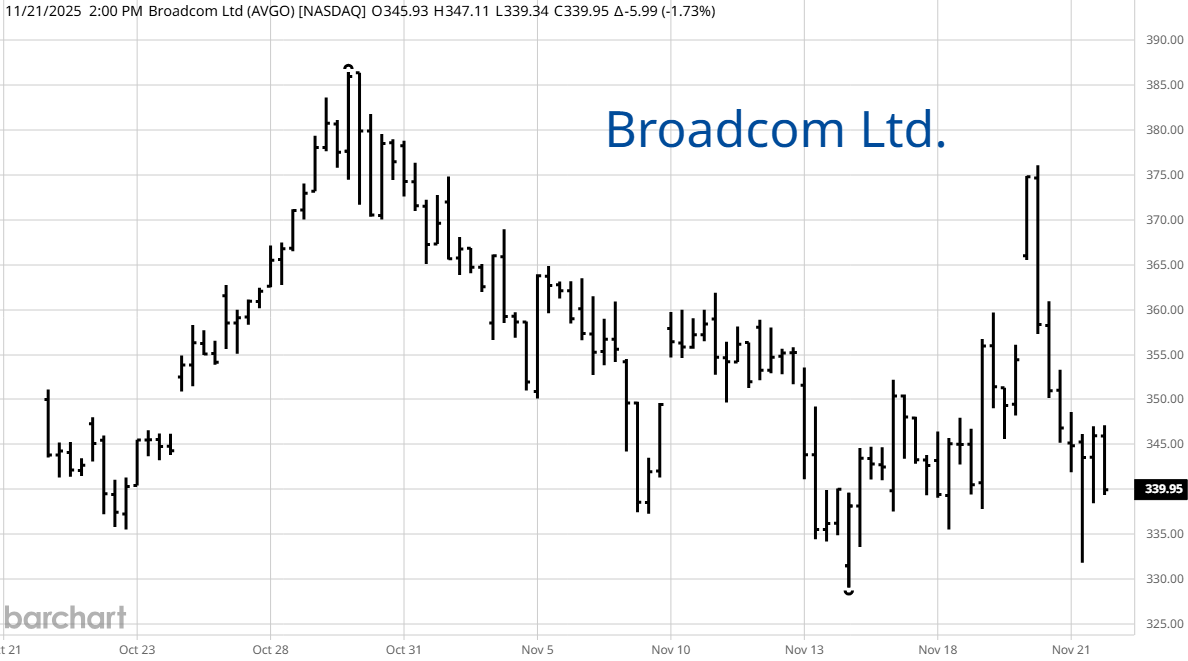

The last update referenced a Wall St. Journal opinion piece that mentioned new wafer technology that will eventually replace microchips. It needs less energy, water and physical space. I also wrote that no one wants to talk about this innovation because of the tens of billions of dollars invested in the current technology but behind the scenes, smart money will begin to move. Above are four AI favorites with two hour bar charts starting on October 22nd, 4 days before the WSJ article. During 2025, more and more wealth was concentrated in a small cluster of names associated with AI. When these stocks falter it has a larger effect on investors' feeling about things in general. The top 10% of income earners drive 50% of the consumption in the country. Their 3 pillars of well being are their jobs, the value of their real estate and their stock portfolio. When these pillars look fragile, investors cut back on spending in general.
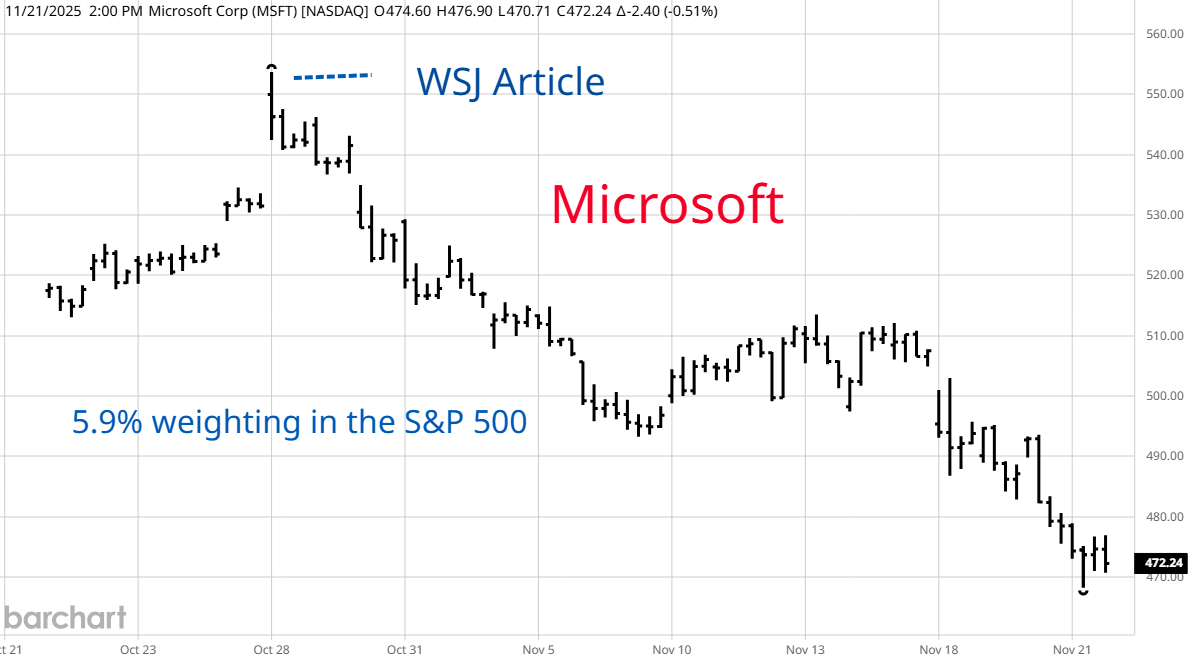

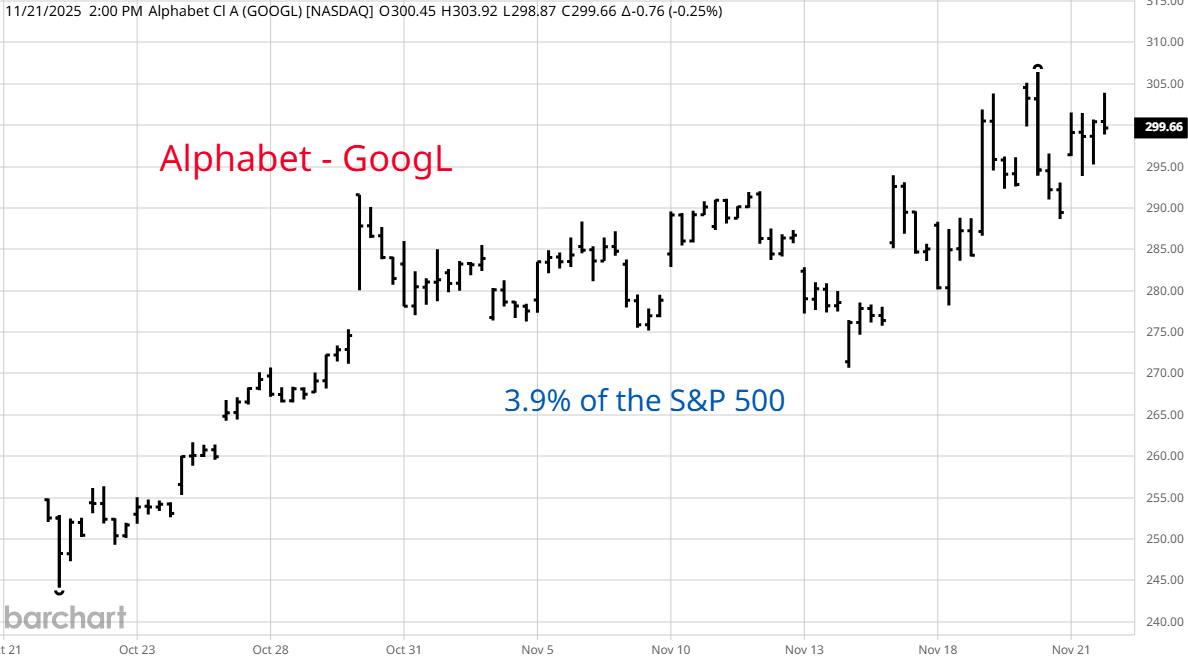
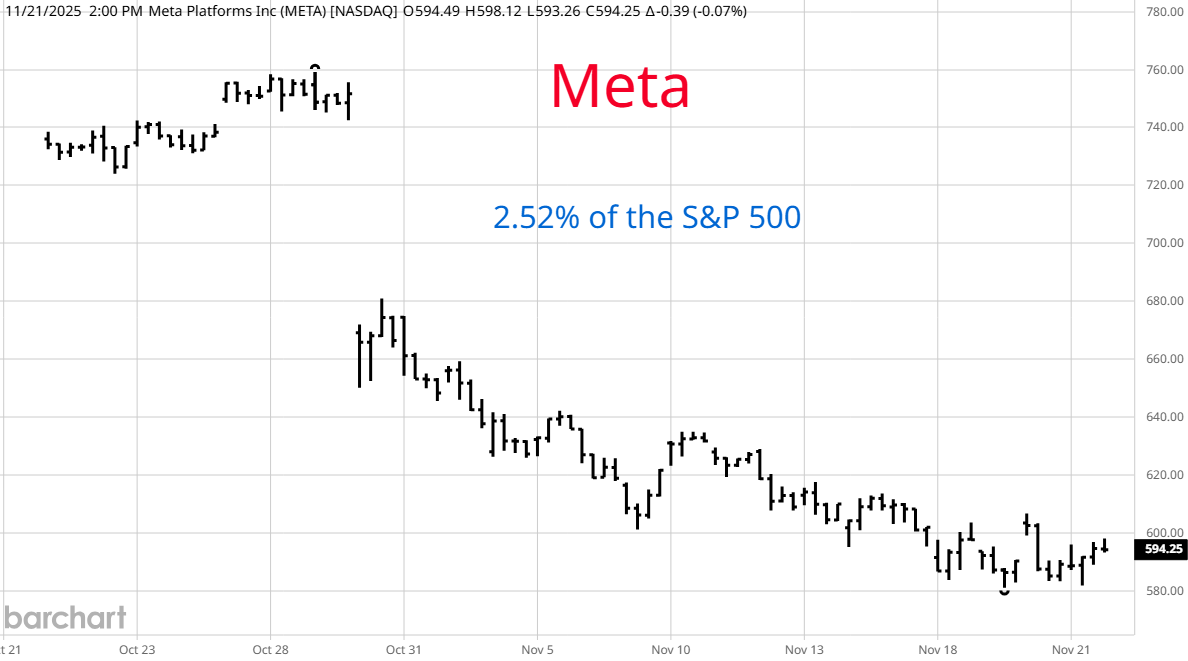
Nvidia and Broadcom make up 10% of the S&P 500. Big buyers of microchips for AI are 16.22% of the Index. Google is working on their own chips and software so that they can be less reliant on Nvidia. They also got a boost when Berkshire Hathaway bought a chunk of Google. Over the decades, Warren Buffett bought low and sold high. It was unusual for his company to buy near all time highs, however, he is retiring from the company and new people are making the decisions. Near the peak of the market, lots of commentary appeared, talking about "passive investing" in S&P 500 Index funds and how these heavily weighted AI oriented companies could not go down in price because contributions to 401K plans would provide a permanent bid under the stocks. If this group continues to be weak, watch for articles on smart investors switching out of S&P 500 Index funds because a few of the most heavily weighted companies are hurting returns. I will also look for the creation of "Everything But AI" S&P Index funds that give you all the index minus the AI companies.
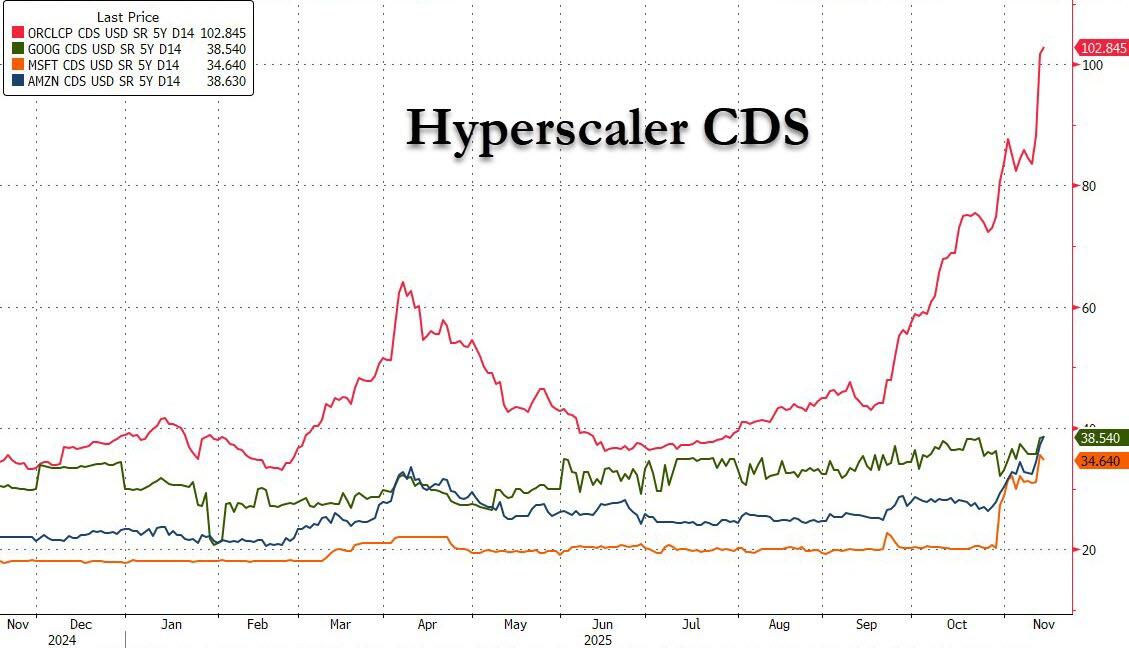
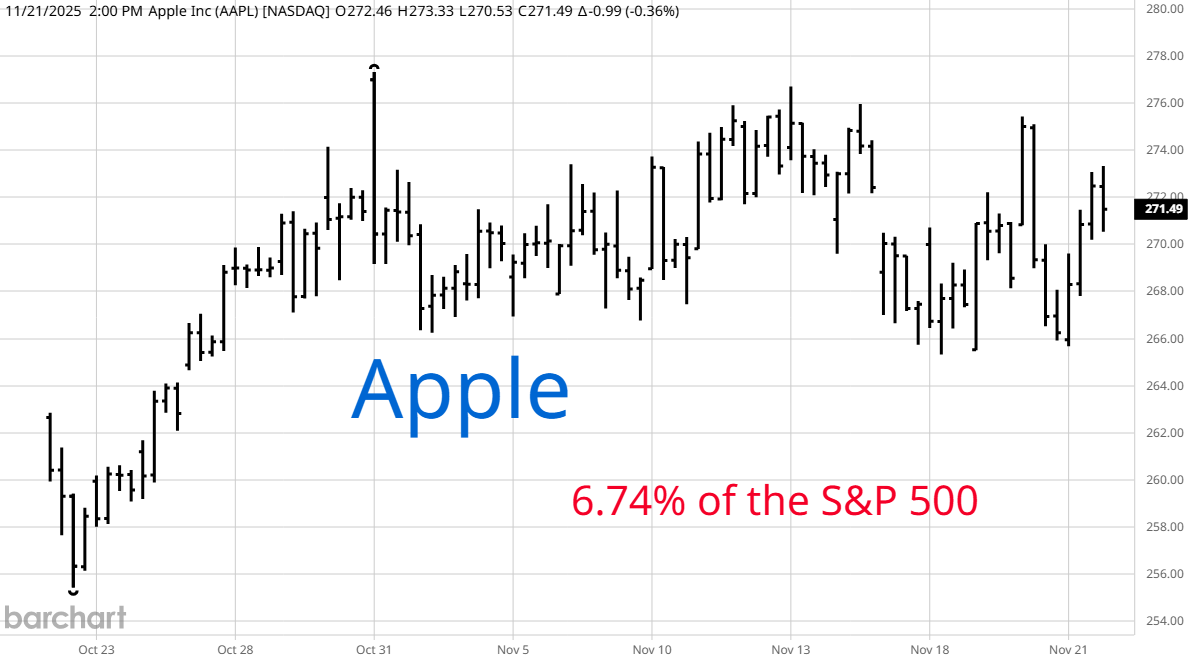
Long time readers might remember that when the hyper-scaler buyers of Nvidia chips boasted about the tens of billions they were going to spend for AI and their stocks exploded higher, I wrote that historically, stocks don't do well after excessive expenditures linked to future speculative returns. Recently, the market agreed with me. On the left is a chart showing the price of Credit Default Swaps on Oracle, Google, Microsoft and Amazon. These are insurance contracts on the debt of the biggest spending AI companies. Apple might come out as the winner. Amid the AI spending frenzy they were heavily criticized for not having an AI strategy. Now, they look smart for not dumping billions into first generation hardware. They face their own issues which are a turn down in consumer spending and the fact that their sales have not increased much over the last few years. They consistently buy back millions of their own shares, shrinking the float which makes their earnings per share look good.
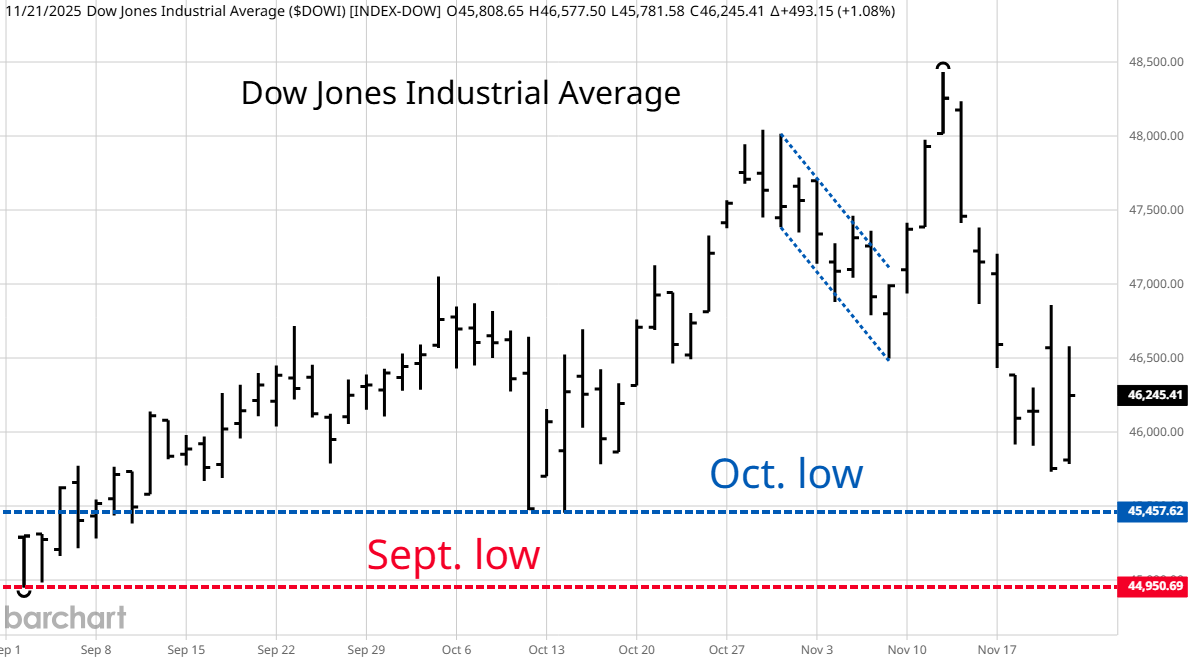
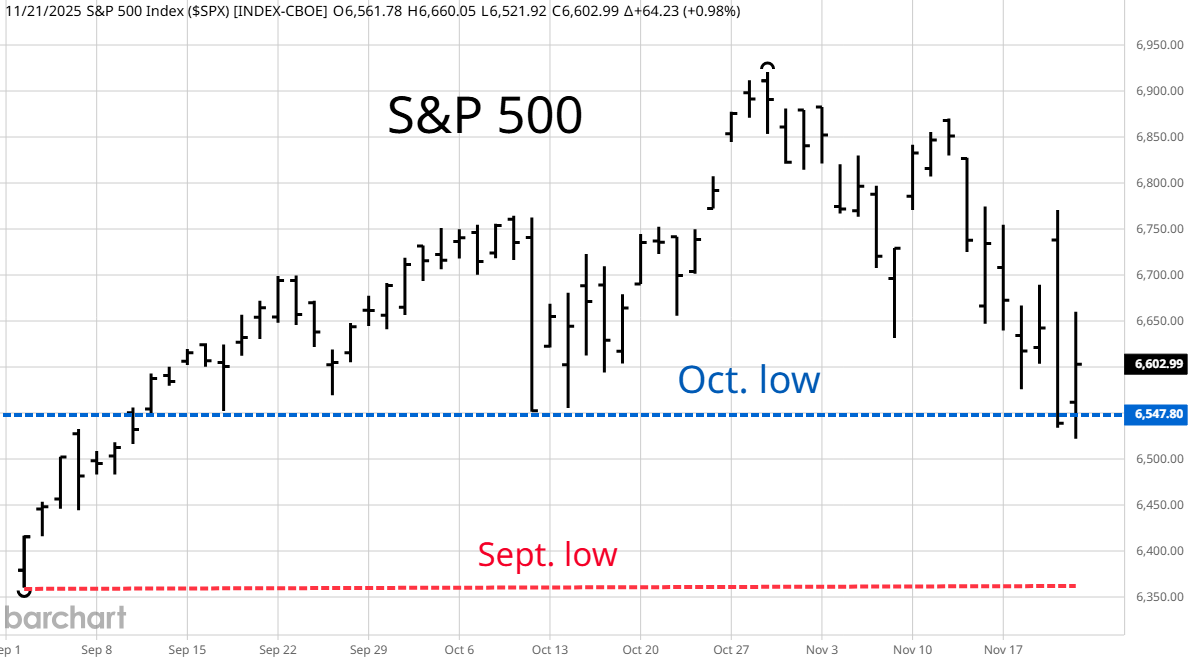
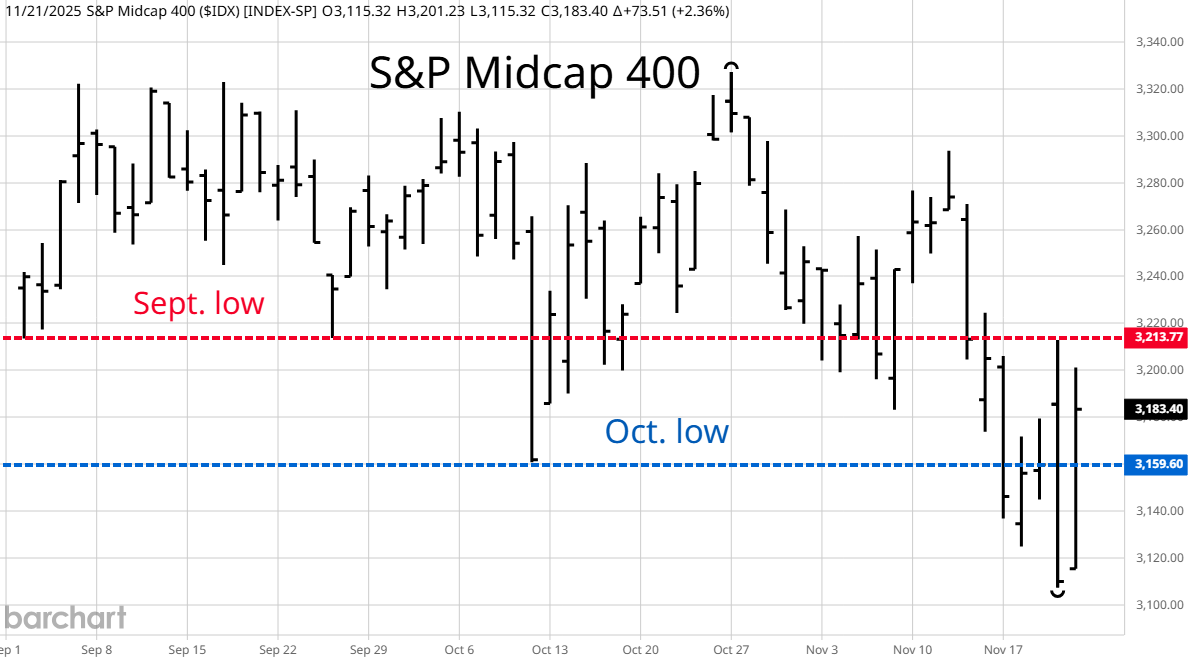
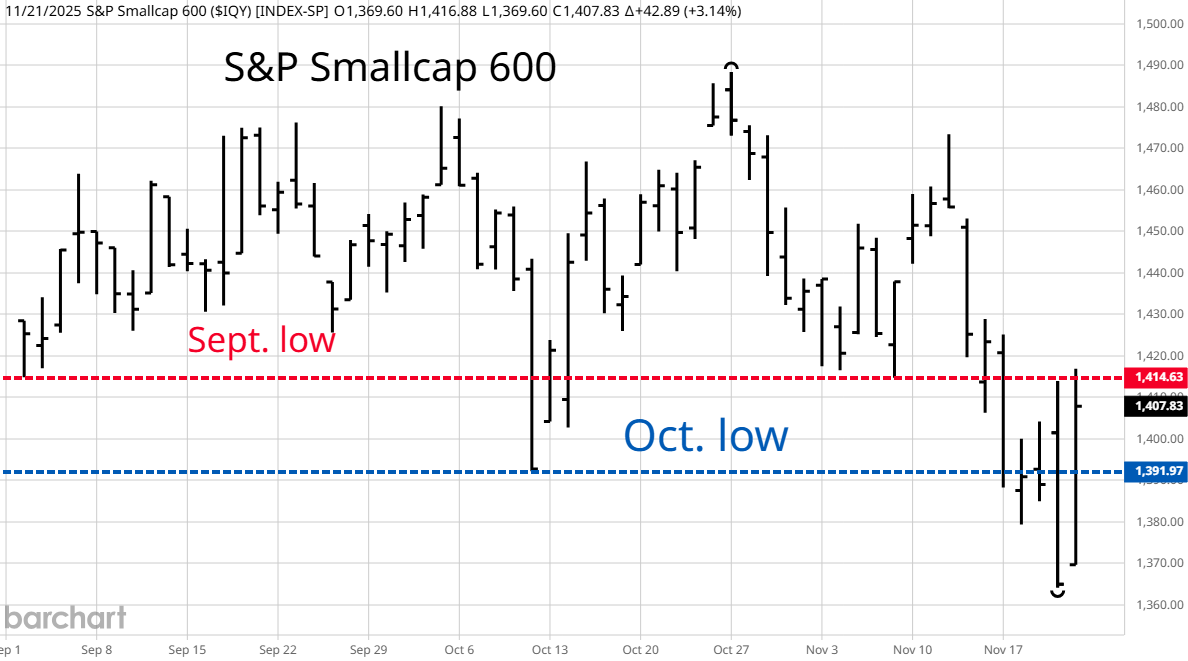
Above are four graphs showing popular market benchmarks. A lot of trend following programs use moving averages and monthly low points. Taking out the low from a previous month turns swing traders from bullish to bearish. The most widely benchmarked index, the S&P 500 poked through its Oct. low before recovering on Friday. With the AI story faltering, money managers will want to keep you in stocks by suggesting that other parts of the market are "undervalued" and they will point to midcap and smallcap stocks. These groups of shares did not do as well as the big boys when measurements of economic activity were better than they are now. How will they make more per share in a slowing economy?
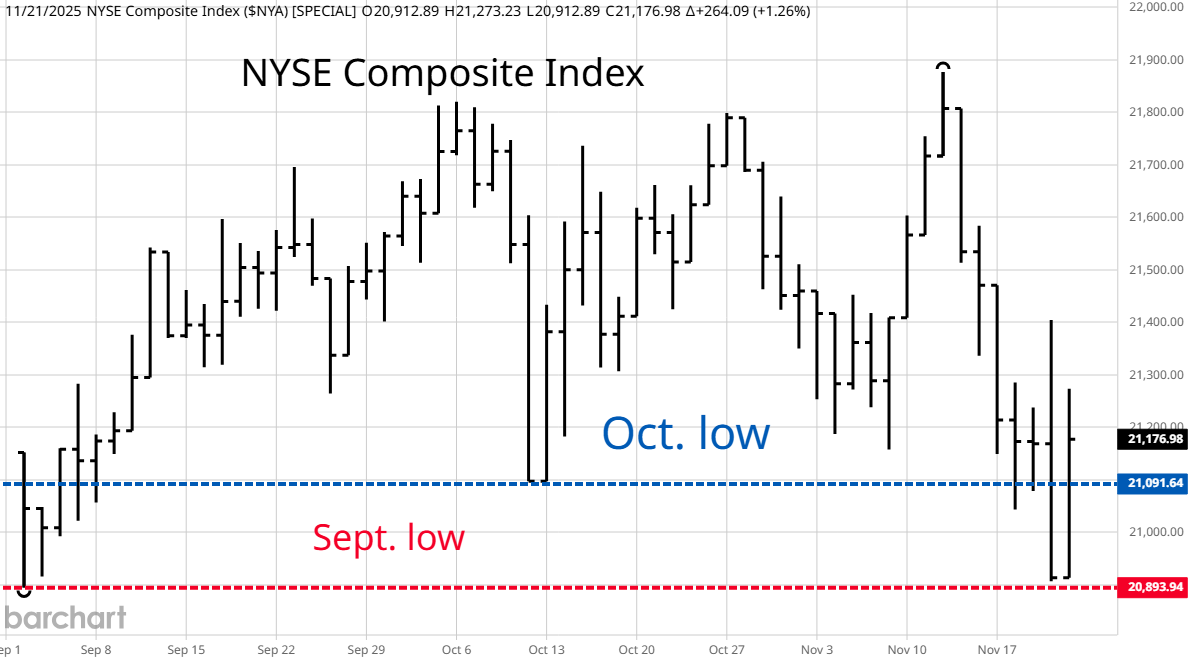

On the left is the NYSE Composite that includes all the stocks traded on the New York Stock Exchange. It came close to taking out its September low on Friday. Another way to think about monthly lows is that when a market falls below the last one, everyone who bought over the last month is now sitting on a loss. The "I am going to stick with this" conviction reaches its high around market tops. It only takes one or two bad monthly 401K statements to fold into "maybe I had better get out!" On the right is a graph I featured in October when everyone was telling you that "seasonality" would cause the market to melt up between mid-October and then end of the year. Last week, the mantra was that stocks always go up the last 6 trading days of November and the first week or two of December. In 2007, the low came late, on Nov. 28 and the rebound was good but failed to take out the previous high. In some updates I mention Cyclesman.com, my favorite subscription. He has a 39 day low to low trading cycle. The last one was October 10th. The next one is due the first week of December. Sometimes, when a market takes a bad fall, the cycle bottoms a bit early so Friday could have been it but I want to get through the next week or two or see good upside follow through to Friday's rebound before giving the all clear signal.


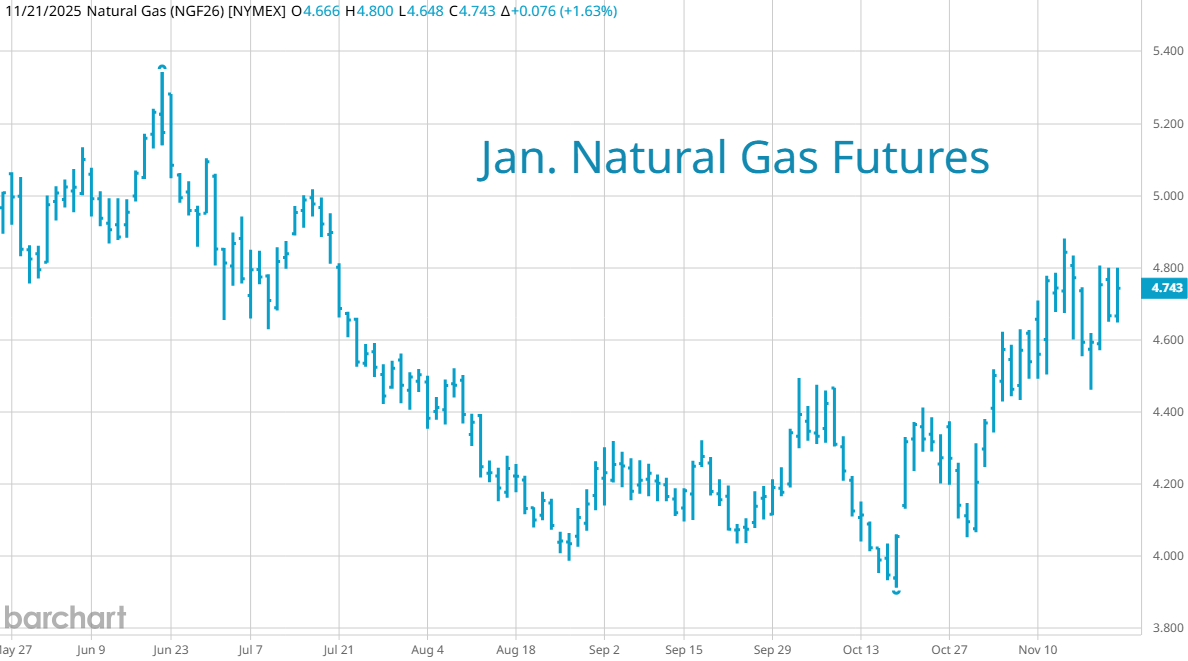
With AI plays faltering and some of the excitement coming out of gold, there is more and more talk about how energy is the next gold and that companies in the energy patch are "cheap." On the upper left is a graph of West Texas Crude from the Russian invasion high. On a seasonal basis, oil tends to be weak into late December or early Jan. Rumors of a peace deal between Russia and Ukraine are making the market nervous because any settlement would mean more Russian oil, gasoline and diesel. On the upper right is a graph of XLE, the big energy ETF along with crude oil. Despite lower oil prices, these stocks are doing well. It is one thing to say they are cheap relative to Microsoft. It is another to say they are cheap then notice that the commodity with which they correlate best is sinking. On that basis, they are richly valued. Part of the reason they have done well is all the talk about the energy needs of AI. Oil is not going to be the form of energy used in generating electricity. Natural Gas will be the hydrocarbon used. Bulls on natural gas argue that demand will increase as individual or clusters of data centers invest in gas fired power plants near them to provide their own cheaper electricity. There are new LNG plants coming on-line over the next two years that will also create more demand. However, the current supply of natural gas seems endless. In the Permian Basin, it often sells for nothing because it is a by-product of oil wells. The problem has been pipeline capacity to take it to markets and huge pipelines are being built. Their completion will coincide with the LNG plants opening so there is a question of just how much these export plants will boost demand over existing supply. Short term, LNG trades on weather. There is talk about a polar vortex hitting the central and eastern part of N. America after Thanksgiving. Gas often peaks in the early days of a big weather event so watch for a post-Thanksgiving high.
I follow Martin Armstrong's writings. All of his cyclical work points to 2026 as a year of chaos, social unrest and wars. This certainly sounds bullish for energy. However, if tanker traffic comes to a standstill because of international risks, won't that mean an increasing domestic surplus? You could see a widening spread between oil contracts in non-producing countries and those that have their own ample supply.



The upper left graph shows daily bars of spot gold in NY. The upper right chart uses the same data and adds the daily percent change in the Dollar Index to show how gold is trading minus the currency influence. A chart wonk case can be made that gold traced out a contracting triangle and burst higher. Text book theory would call for an eventual return to the contracting sideways pattern. One could make the argument that the final burst higher is not complete. Usually, a big spike up is followed by a correction then a slightly higher peak before a stronger pull back.
On the left is a graph of the weekly closing spot price in NY and a simple RSI momentum oscillator. If you are a value type investor you want a lower reading on the oscillator before you buy.
The "markets are driven by liquidity" theorists say that gold is also governed by liquidity. Gold is now top tier collateral at banks and that will put a floor under it but as the 6.5 year liquidity cycle peaks, gold will be vulnerable to a pull back.
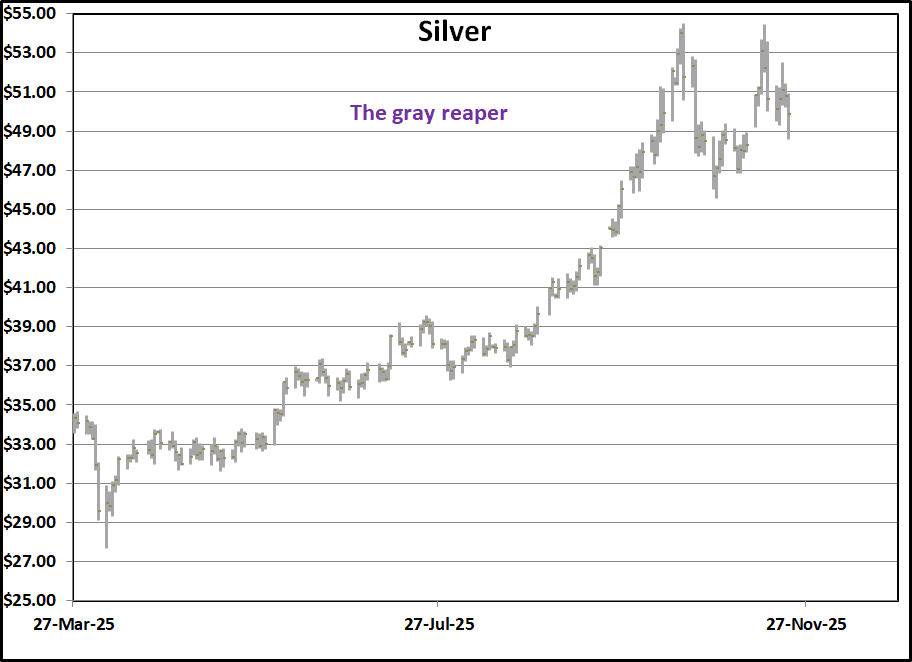
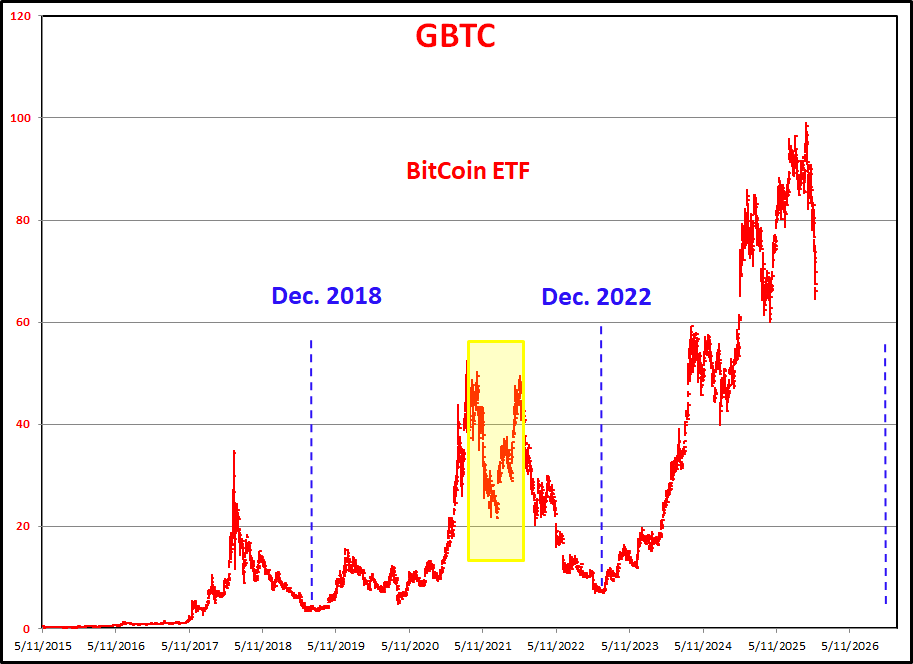
Last week, silver seemed to follow the stock market's moves. On my weekly graphs it is still too technically over bought. On the right is GBTC, a popular Bitcoin ETF. In October, fans were telling us that Bitcoin was digital gold. Right before it hit the skids, one popular analyst called for $200,000 by the end of January. Lately, Bitcoin analysts have been talking about a four year cycle for crypto with December 2018 and 2022 the last low points. The inference is that it will be a buy again late in 2026. The more popular this theory becomes, the more likely it is that crypto will do something else. The yellow box marks the last four year top. Notice that it wasn't all straight down. It had a robust rebound before grinding owners down for the next few years.
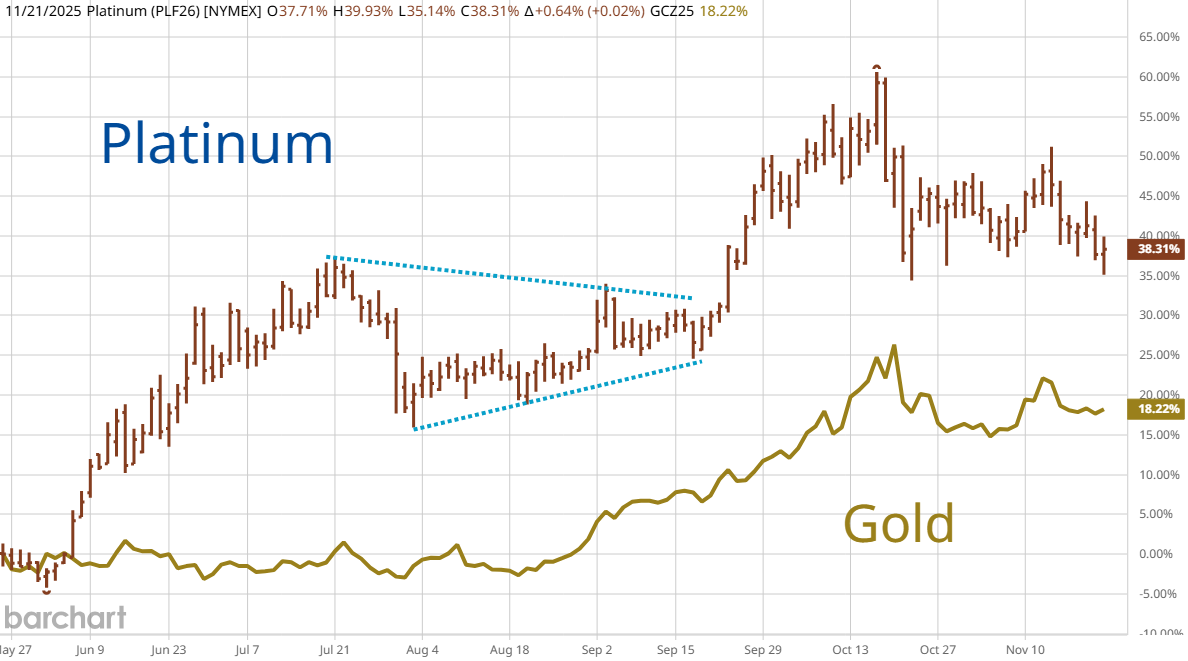

Platinum and Palladium continue to track gold prices. 40% of the newly mined palladium and 10% of the platinum come from Russia with almost all the rest from S Africa. The limited sourcing alone makes the supply of these metals more fragile. If Armstrong's predictions of war and chaos for 2026 are right, both metals could do well.
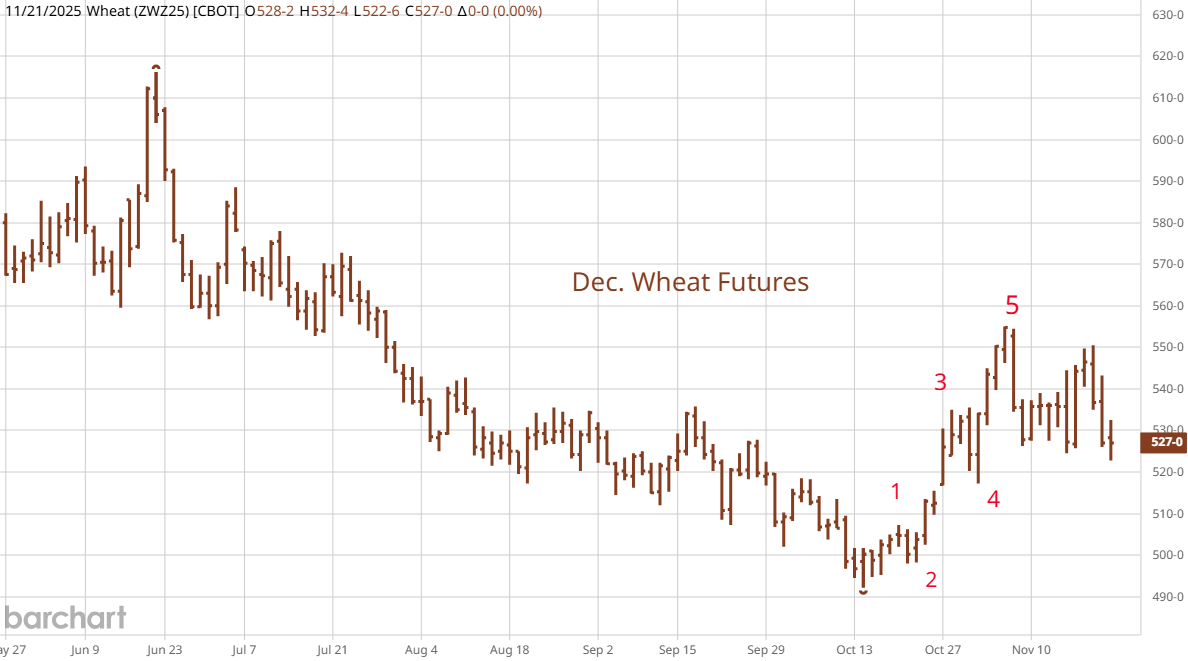
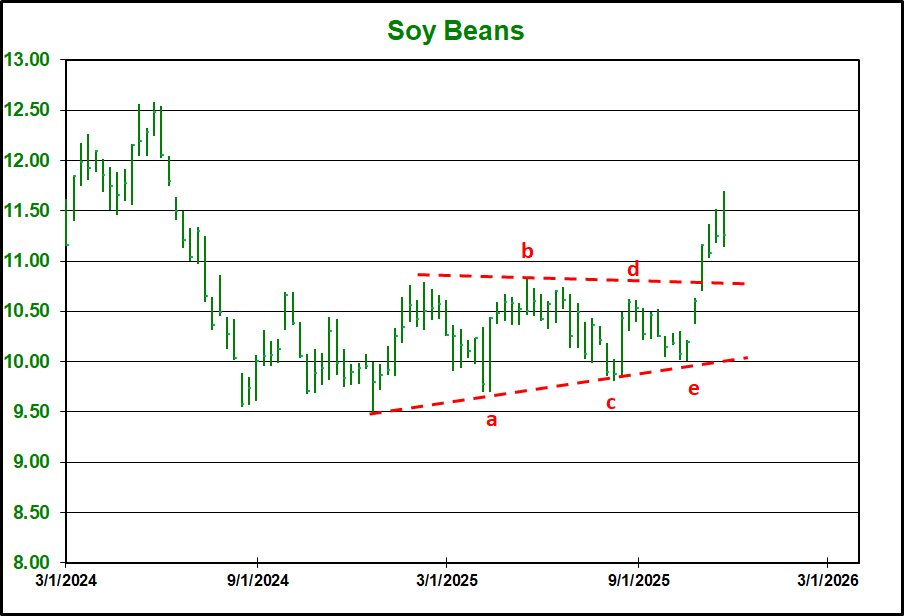
My favorite dog, Wheat, did well over the last month and it rallied in a five wave up move, a pattern that chart wonks believe will have more follow through to the upside. Ukraine and Russia are both big wheat growing countries so peace will not be good news. On the right is a weekly graph of soybean prices, For a while, the sideways contracting move kept the market in suspense. New agreements with China sparked the upside breakout. Traders will want to see it hold above the upper red dashed line and are likely to dump positions if it falls back below it. Trade deals or no trade deals, weather is the ultimate driver for both these markets.
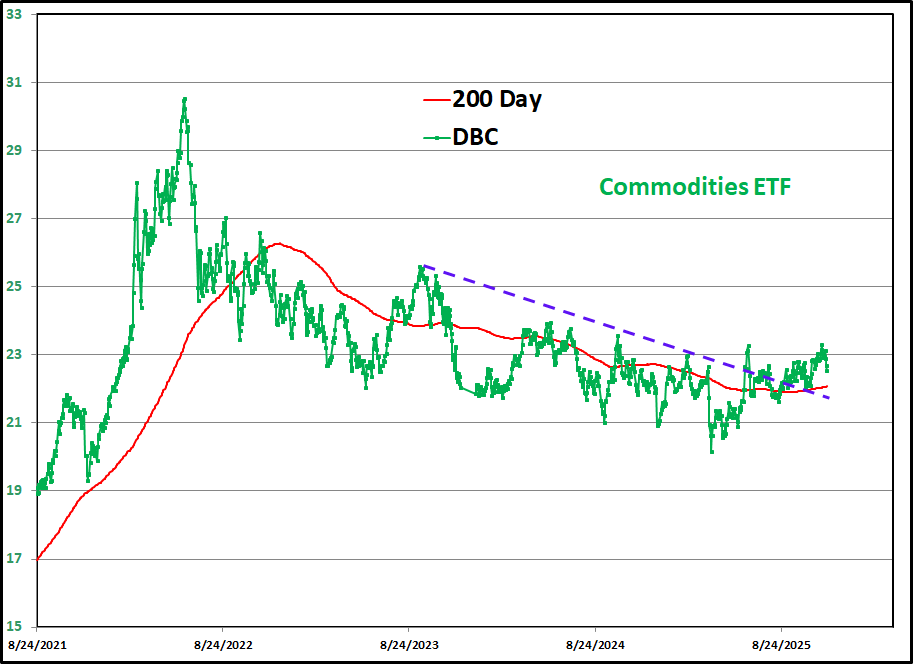

Above are two popular commodity tracking ETFs. DBC is more weighted to grains and GSG to energy. Lately there are more analysts talking about a commodities super-cycle. Around the highs in both these charts, everyone was convinced that commodities were going to surge, just like they did in the 1970s. Gold and silver did well but most other things are lagging. Both sets of prices are above their 200 day moving averages but they have been there before with poor follow through. Is the cycle for real or are Wall St. firms worried about AI and looking for a new way to keep investing your money. When I started at E. F. Hutton in 1980 I had to go to a 2 week training course in New York City. One of the lessons was to always keep your clients in the market because if they went to cash, they would be reluctant to get back in and your commissions would suffer.
 Best Guesses -
Best Guesses -
Stocks - Now, we have to pay attention to liquidity along with economic data, earnings and chart patterns. Given its recent mention in the media, it will play an increasing part in investor's decisions. If history is repeated, we should get some kind of bounce in December. If it fails to do much, selling will return. Watch for sector rotation out of AI and talk about getting away from S&P 500 Index funds. With all the investment coming into the U.S. it is likely that other sectors will shine after a pull back.
Bonds - They moved counter to the stock market over the last two weeks so watch for that to resume. Trillions of dollars need to be refinanced over the next few years which means competition for borrowable funds. The Fed might lower overnight rates but without serious signs of an economic slowdown, it is unlikely that rate cuts will influence the longer end of the curve.
Dollar - The world needs Dollars to run. I expect it to remain firm. Dollar based stable coins only make it more attractive.
Gold and Silver - I am neutral to bearish on the metals for now.
Commodities - China's stock markets sold off last week despite massive amounts of liquidity added to their financial system. It goes to show that it isn't just liquidity alone. You also need confidence in the future. If this keeps up you can forget about any commodities super cycle. I still like wheat longer term and natural gas into the cold spell.
Oil - I am hoping for a December low and a sell off in oil patch stocks at the same time so I can get a real deal.
Best of luck,
DBE